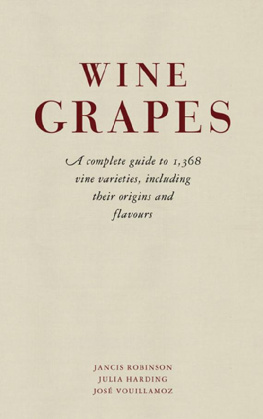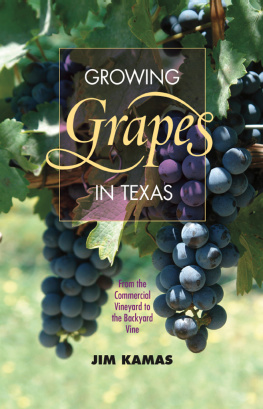Robinson Jancis - Wine Grapes: a complete guide to 1,368 vine varieties, including their origins and flavours
Here you can read online Robinson Jancis - Wine Grapes: a complete guide to 1,368 vine varieties, including their origins and flavours full text of the book (entire story) in english for free. Download pdf and epub, get meaning, cover and reviews about this ebook. year: 2013, genre: Home and family. Description of the work, (preface) as well as reviews are available. Best literature library LitArk.com created for fans of good reading and offers a wide selection of genres:
Romance novel
Science fiction
Adventure
Detective
Science
History
Home and family
Prose
Art
Politics
Computer
Non-fiction
Religion
Business
Children
Humor
Choose a favorite category and find really read worthwhile books. Enjoy immersion in the world of imagination, feel the emotions of the characters or learn something new for yourself, make an fascinating discovery.
- Book:Wine Grapes: a complete guide to 1,368 vine varieties, including their origins and flavours
- Author:
- Genre:
- Year:2013
- Rating:4 / 5
- Favourites:Add to favourites
- Your mark:
- 80
- 1
- 2
- 3
- 4
- 5
Wine Grapes: a complete guide to 1,368 vine varieties, including their origins and flavours: summary, description and annotation
We offer to read an annotation, description, summary or preface (depends on what the author of the book "Wine Grapes: a complete guide to 1,368 vine varieties, including their origins and flavours" wrote himself). If you haven't found the necessary information about the book — write in the comments, we will try to find it.
Robinson Jancis: author's other books
Who wrote Wine Grapes: a complete guide to 1,368 vine varieties, including their origins and flavours? Find out the surname, the name of the author of the book and a list of all author's works by series.
Wine Grapes: a complete guide to 1,368 vine varieties, including their origins and flavours — read online for free the complete book (whole text) full work
Below is the text of the book, divided by pages. System saving the place of the last page read, allows you to conveniently read the book "Wine Grapes: a complete guide to 1,368 vine varieties, including their origins and flavours" online for free, without having to search again every time where you left off. Put a bookmark, and you can go to the page where you finished reading at any time.
Font size:
Interval:
Bookmark:
Wine Grapes
A complete guide to 1,368 vine varieties, including their origins and flavours
JANCIS ROBINSON
JULIA HARDING
JOS VOUILLAMOZ

Contents


I find it difficult to express how thrilled I am to have created this entirely new book with co-authors as knowledgeable and gifted as Julia Harding MW and Dr Jos Vouillamoz.
In the mid 1980s I wrote the first consumers guide to wine grape varieties, Vines, Grapes & Wines , published in 1986 and still in print, an amalgamation of all that I could find out about the vines then planted for wine production around the world. At that stage all that was available were the highly academic works of French vine expert Pierre Galet of Montpellier and an American adaptation of part of them by his pupil Lucie T Morton. The French in particular regarded varietal wines, which they called vins de cpage , wines named after the grape variety from which they were made rather than after the place they were grown, as inherently inferior. It was all the more surprising then to find that the book was so sought after, not just in English and German but also in French as Le Livre des Cpages . It seemed as though not just wine consumers but also French vine growers had a distinct thirst for information about vine varieties and how they were related.
I have always been fascinated by grape varieties, especially by their extremely complex synonymy and how one vine can turn out to be identical to another with a quite different name and reputation in another country. I have paid particular attention to the grape variety entries in all three editions of The Oxford Companion to Wine and Oxford University Press even published a collection of them in pocket-book form in 1996 as Jancis Robinsons Guide to Wine Grapes , a book I know many people still consult. But they should all throw it out immediately because this book, while hardly being pocket size, is so much more up to date and comprehensive than either of my previous works on the subject.
While the range of varieties now knowingly and deliberately used for commercial wine production has expanded enormously in this new century, our knowledge of the relationships between these varieties is infinitely greater than it has ever been. Thanks to the DNA profiling that has been applied to grapevines since 1993, specialists such as Dr Jos Vouillamoz (who identified the parents of Sangiovese in 2004 and two years later discovered a fascinating family relationship between Pinot and Syrah) now understand so much more about the pedigrees of the worlds plants, including grapevines.
As those who read this book will learn, a mere handful of founder varieties (similar to founder crops) such as Pinot, Savagnin, Nebbiolo and Tribidrag are ancestors of dozens of often much more familiar grapes, and it looks increasingly as though an enormous proportion of the grapes we know today are members of a few key families, all clearly illustrated in our unique . As ever, the study of wine grapes tells us much about social history and the movement of people and conquerors.
With its detailed information on the viticultural characteristics of each variety, this book should prove a boon for growers trying to decide which vines might thrive in their particular circumstances, while its unrivalled wealth of topical detail about where each variety is grown, to what extent, and how the wines made from that variety taste, will, we feel confident, fill a significant gap in the current literature available to wine lovers.
The total number of different vine varieties is about 10,000, members of half a dozen species. In order to make this book manageable, we have decided to limit ourselves to those varieties which we know at the time of writing produce commercial quantities of wine, all 1,368 of them. But such is the current explosion of interest in lesser-known grapes that we fully acknowledge, and indeed welcome, the fact that some wines produced in 2012, and possibly some 2011s, will have been made from grape varieties not mentioned in this book. We welcome suggestions for varieties to be included in any subsequent edition, and ask that they be sent to contact@winegrapes.org.
It is worth pointing out, however, that most grape varieties travel under a wide variety of aliases. We have tried to include all correct, and the most prominent incorrect, synonyms. (see below) outlines our procedure and conventions in detail.


The 1,368 grape varieties described in this book are presented in alphabetical order. Where a variety is known under several different names, we have selected a prime name, which is generally the name most commonly used in the varietys country or region of origin. For example, Garnacha is the prime name rather than Grenache because the variety originates from Spain, where Garnacha is the most common as well as the official name. Well-known synonyms such as Grenache do appear in this alphabetically ordered book but only to point to the entry under the varietys prime name (eg Grenache, see ).
As explained on entry.
However, when there are several varieties that have similar names but are genetically distinct (eg Malvasia di Candia Aromatica, Malvasia di Casorzo, Malvasia di Lipari, etc), they are given separate entries. In such instances, there is usually another short introductory entry that explains the possible connections or distinctions among them (in this instance, the entry headed ).
Within each entry, the first instance of a prime name in any paragraph is highlighted as a link in SMALL CAPITAL LETTERS so that you can easily jump to those entries for more information.
As there is so much confusion over synonyms, and many instances where one variety is wrongly considered to be the same as another, most entries begin with a list of synonyms for that variety and a list of varieties that are commonly mistaken for it. Where such synonyms and mistaken identities have been proven by DNA analysis, the variety name or synonym is marked .
The berry colour of each variety and for the most important colour mutations (see p ) is described in idealized terms (eg black, white, grey, pink), giving the closest approximation to the actual colour of the fruit on the vine, which is rarely uniform.
For each variety we give the total vineyard area planted with that variety for each country and/or region where relevant, based on the most recent statistics we could find. These are usually based on a vineyard census undertaken within the past few years but the Italians carry out a survey of their vines only once a decade, so figures for plantings in Italy are necessarily dated. The anticipated 2010 Italian viticultural census had yet to be published in late 2012, unfortunately.
In every entry, in the section entitled Where its grown and what its wine tastes like, we have discussed each relevant country or region in the same order (France, Italy, Spain, Portugal, Northern Europe, Germany, Austria, Switzerland, Eastern Europe, the eastern Mediterranean, California, Washington, Oregon, the rest of the US, Canada, Mexico, South America, Australia, New Zealand, South Africa and finally Asia) no matter where that variety is most important. Thus, for example, the Tempranillo section begins by considering the limited extent to which this Spanish grape is found in France.
Next pageFont size:
Interval:
Bookmark:
Similar books «Wine Grapes: a complete guide to 1,368 vine varieties, including their origins and flavours»
Look at similar books to Wine Grapes: a complete guide to 1,368 vine varieties, including their origins and flavours. We have selected literature similar in name and meaning in the hope of providing readers with more options to find new, interesting, not yet read works.
Discussion, reviews of the book Wine Grapes: a complete guide to 1,368 vine varieties, including their origins and flavours and just readers' own opinions. Leave your comments, write what you think about the work, its meaning or the main characters. Specify what exactly you liked and what you didn't like, and why you think so.











